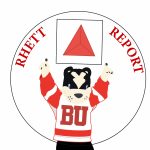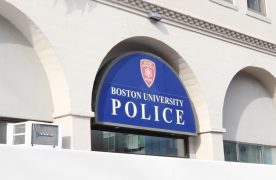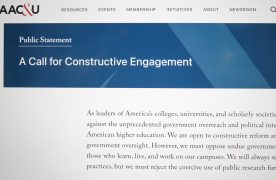When the stock market tumbled in late 2000, it carried with it the assets of numerous individuals and organizations — including those owned by Boston University.
BU’s endowment, valued at nearly a billion dollars in 2000, declined in value 28 percent in the space of a year, carrying a value of $674.1 million in 2001. Figures were not available for the 2002 endowment level, but BU spokesman Colin Riley said the steep drop in the endowment’s value was slowing.
The drop, according to Riley, “reflected a decline in the overall market.”
This decline, however, does not necessarily spell trouble for BU. According to Riley, this marked depreciation in BU’s stock portfolio does not affect the day-to-day operation of the university.
Endowment is an integral element of a non-profit organization’s finances, according to School of Management professor Jeff Heisler.
“They’re typically important because they generate the income that [organizations] use to cover expenses,” Heisler said. “Basically the money they need to run the university comes from the endowment and the funds it generates.”
Universities may also glean funds from alumni donations, Heisler said. Relying on donations, however, presents a difficulty.
“The problem with relying on alumni donations is that they can be targeted to particular areas … and they may just not be enough to cover all the needs the university has,” Heisler said.
This is true for several major universities, most notably Dartmouth College, which draws 30 percent of its operating budget from returns on endowment, according to a recent Boston Globe article. The decline in the value of Dartmouth’s endowment has prompted officials to make budget cuts, including the possible elimination of the school’s swimming program.
However, Riley said BU has no worries about the value of its endowment because very little of its operating budget comes from the endowment.
According to Riley, BU is not an “endowment dependent university, and we had a very insignificant return on endowment go to the operating budget.”
BU drew only $4.5 million from the endowment returns for operational costs last year, Riley said. This constituted less than one percent of the university’s $1.3 billion operating budget, he said.
Instead, the university gleans the funds for its operating budget from tuition, sponsored research and other revenue-generating areas, including Campus Convenience, Riley said.
The $250 to $280 million the university received for research “reflects well on faculty winning awards and grants to do important research,” Riley said.
The university also received $90 million in gifts last year, reflecting a rise that has continued despite the same difficult economic times that cause the endowment’s value to tumble. However, these gifts are allocated for a specific purpose, Riley said.
“Our operating budget has had surpluses every year for the last 30 years — the endowment has had excellent returns in the last decade except for the last couple of years,” Riley said.
The amount the endowment contributes to the operating budget is “a very insignificant amount of contribution,” Riley said.
Despite the “insignificant amount” the endowment contributes to daily operations, BU should be examining its assets, according to Heisler.
“Anybody whose portfolio has dropped in value should be taking a look at it,” Heisler said. “Any time a portfolio drops in value, you go back and reassess what you’re invested in, why you’re invested in it.”
In some cases, Heisler said, a drop in the total value of an endowment may not be a cause for great concern, provided it is still fulfilling the needs of an organization.
“When you construct a portfolio you can’t worry just about maximizing return,” he said. “It’s not just returns that are part of the problem.
“The problem is a little more complicated than just worrying that the value of a portfolio has fallen,” Heisler said.
Heisler said organizations must also examine the risk level of a portfolio; a portfolio may provide high yields, he said, but these yields come with risks. These may be risks an organization is unwilling to take, especially if it relies on its endowment for operational funds.
“The other real issue is the risk of the portfolio, particularly when it is a portfolio that is being used to generate income to meet operational costs because those consistently don’t go away,” Heisler said.
“The portfolio may be in fact doing what they want it to do — meeting income requirements,” he said. “The overall value may not be a concern.”
“One of the truisms of investing is that you can’t make your portfolio do what you want it to do,” Heisler added.
The decline in BU’s endowment, which, according to Riley, is “variously allocated in a broad mix of investment portfolios,” comes after a 30-year period of growth.
BU’s endowment was valued at $18.8 million in 1970, $139.2 million in 1986, $233 million in 1991, $666.1 million in 1999 and $930.2 million in 2000, before falling back to $674.1 million in 2001.
Riley said he believed the 2002 numbers would not decrease as much as the 2001 numbers did.
“Now there’s some leveling off … we believe this (the lengthy decline in the market) is probably an aberration and the market’s going to return to strength,” he said.
Riley said this drop was related to the stock market and the progress of the endowment would turn around once the markets recover from their recession.
“When the financial markets return, we expect growth in our endowment to return,” Riley said.
Despite the loss of nearly a third of its value, BU’s investments have still fared better than others, Riley said.
BU’s endowment has outperformed the market indices in which the investments are made, specifically the Russell 500 and the Standard and Poor, Riley said.
“I think we outperformed them even when they hit a decline,” Riley said. “That’s really what you shoot for when investing.”
This is an account occasionally used by the Daily Free Press editors to post archived posts from previous iterations of the site or otherwise for special circumstance publications. See authorship info on the byline at the top of the page.












